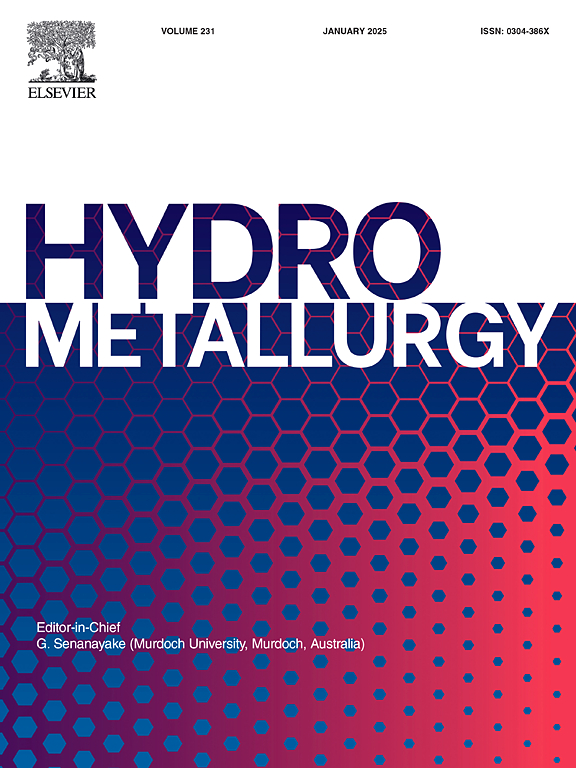The role of P(V) salts in inhibiting CaCO3 precipitation in the uranium in-situ leaching process using CO2 and O2
IF 4.8
2区 材料科学
Q1 METALLURGY & METALLURGICAL ENGINEERING
引用次数: 0
Abstract
Addition of chemical agents to inhibit the CaCO3 precipitation process is a potential way to solve the blocking problem in the industrial in situ leaching process for uranium recovery. This research investigated the role of P(V) added as sodium hexametaphosphate ((NaPO3)6), anhydrous sodium pyrophosphate (Na4P2O7), and sodium tripolyphosphate (Na5P3O10) as inhibitors for the precipitation of CaCO3 in supersaturated solutions of Ca2+ and HCO3−. The results indicated that the three inhibitors prevented the formation and growth of CaCO3 and Na5P3O10 showed the best performance. In the aqueous phase Ca2+ coordinated with P(V) ions to form complex anions of Ca-phosphates including CaHP2O7—, CaP2O72−, CaHP3O102−, and CaP3O103−. The role of P(V) as an inhibitor was attributed to the adsorption of P(V) species including Ca![]() P complex anions and phosphate anions on the calcite surface to form an amorphous protective layer which prevented further precipitation of CaCO3 phase. Moreover, dosage threshold of Na5P3O10 was experimentally determined to be 2 mg/L. This dosage gave a CaCO3 precipitation inhibition efficiency higher than 90 %. Injection of inhibitors had no negative effect on the in situ leaching of uranium by CO2 and O2 and subsequent ion exchange adsorption process for uranium recovery.
P complex anions and phosphate anions on the calcite surface to form an amorphous protective layer which prevented further precipitation of CaCO3 phase. Moreover, dosage threshold of Na5P3O10 was experimentally determined to be 2 mg/L. This dosage gave a CaCO3 precipitation inhibition efficiency higher than 90 %. Injection of inhibitors had no negative effect on the in situ leaching of uranium by CO2 and O2 and subsequent ion exchange adsorption process for uranium recovery.
P(V)盐在CO2和O2原位浸出铀过程中抑制CaCO3沉淀的作用
添加化学药剂抑制CaCO3沉淀过程是解决工业原地浸出铀回收过程中堵塞问题的一种潜在途径。本研究考察了P(V)作为六偏磷酸钠((NaPO3)6)、无水焦磷酸钠(Na4P2O7)和三聚磷酸钠(Na5P3O10)在过饱和Ca2+和HCO3−溶液中作为CaCO3沉淀抑制剂的作用。结果表明,3种抑制剂均能抑制CaCO3的形成和生长,其中Na5P3O10的抑制效果最好。在水相中,Ca2+与P(V)离子配合形成磷酸钙络合物阴离子,包括CaHP2O7 -、CaP2O72−、CaHP3O102−和CaP3O103−。P(V)作为缓蚀剂的作用是由于P(V)在方解石表面吸附了包括CaP络合物阴离子和磷酸阴离子在内的P(V)种,形成无定形保护层,阻止了CaCO3相的进一步沉淀。实验确定Na5P3O10的剂量阈值为2 mg/L。该用量对CaCO3沉淀的抑制率大于90%。注入抑制剂对CO2和O2原地浸出铀及随后的离子交换吸附回收铀没有负面影响。
本文章由计算机程序翻译,如有差异,请以英文原文为准。
求助全文
约1分钟内获得全文
求助全文
来源期刊

Hydrometallurgy
工程技术-冶金工程
CiteScore
9.50
自引率
6.40%
发文量
144
审稿时长
3.4 months
期刊介绍:
Hydrometallurgy aims to compile studies on novel processes, process design, chemistry, modelling, control, economics and interfaces between unit operations, and to provide a forum for discussions on case histories and operational difficulties.
Topics covered include: leaching of metal values by chemical reagents or bacterial action at ambient or elevated pressures and temperatures; separation of solids from leach liquors; removal of impurities and recovery of metal values by precipitation, ion exchange, solvent extraction, gaseous reduction, cementation, electro-winning and electro-refining; pre-treatment of ores by roasting or chemical treatments such as halogenation or reduction; recycling of reagents and treatment of effluents.
 求助内容:
求助内容: 应助结果提醒方式:
应助结果提醒方式:


